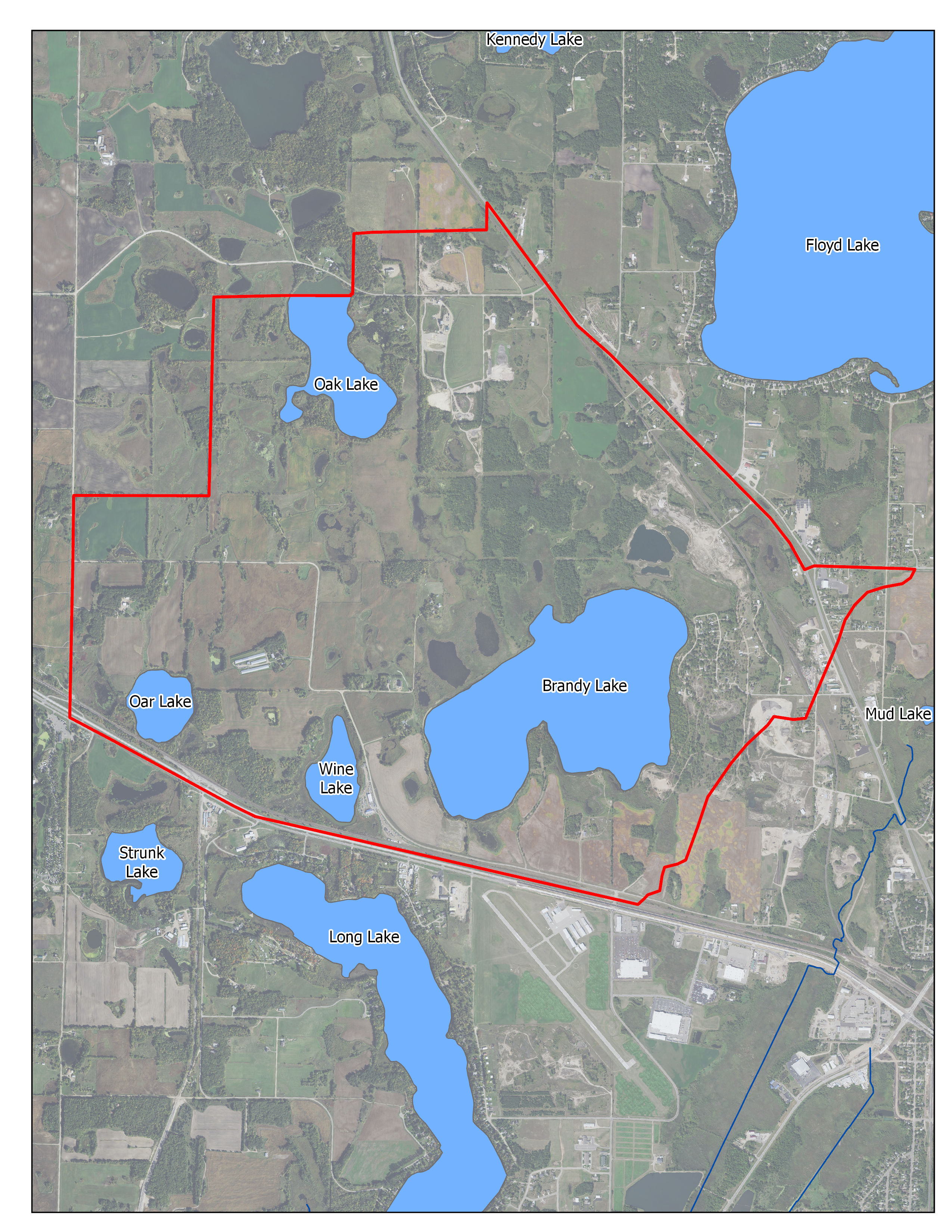Characteristics
| Brandy-Wine Planning Area | |
|---|---|
| Watershed area | 3,000 acres |
| Land Use | 2.7% Impervious 48.6% Agriculture 24.2% Forest 14.2% Water 10.3% Wetland |
| Major Lakes | |
| Shallow Lakes | Brandy, Oak, Wine, Oar |
| Streams/Public Ditches | N/A |
| Impaired On the MPCA Impaired Waters List, Restoration necessary | Wine Lake |
| Enhance Enhance condition to prevent future impairment. Nearly Impaired/degrading trend. | Brandy |
| Protect Maintain good condition and protect against future risks. | N/A |
| More information needed for assessment | Oak, Oar |
Map

Description & Overview
The Brandy WMA contains about 3,000 acres. Four named exist within this area, Brandy, Wine, Oak and Oar, although several very small unnamed lakes and wetlands also dot the WMA. Brandy Lake is the largest lake, at 323 acres. The other lakes are smaller and have small watersheds. Land in the Brandy WMA is mostly used for cultivated crops or pasture. Shoreline along the lakes is mostly undeveloped. This is partly because the shallow nature of these lakes makes them ill-suited for recreation.
Approximately 10 percent of the WMA is owned by the U.S. Fish and Wildlife Service. Water quality of Brandy Lake has improved in recent years and has gone from eutrophic to meeting water quality standards. Brandy has a small inlet with surface drainage that originates near a former Becker County landfill. Water quality improvements may have to do with remediation of this former landfill, where groundwater is currently extracted, aerated, and then discharged to Brandy Lake as part of remediation procedures. Wine Lake is a shallow lake and is listed as impaired due to excess nutrients. It has average annual phosphorus concentrations of 87 ug/L, which is well above the shallow lake standard of 60 ug/L. A TMDL study will be published in 2021. Insufficient data has been collected for the other lakes in this WMA. However, it seems the health of all the lakes in this WMA is impacted by the shallowness of the lakes and past and present land-use practices.
Water Quality Goals
Pollutant/Stressor
Phosphorous
Focus
Nearshore
Goals
Protection- Adaptatively Manage to protect, enhance, and restore water quality.
Actions
- Identify and target critical agricultural erosion areas
- Identify and protect sensitive aquatic Areas
- Treat stormwater discharges through the implementation of District Rules
- Conduct Shoreline Surveys
- Manage Stormwater Runoff through implementation of District Rules
- Lakeshore Protection through implementation of District Rules
Pollutant/Stressor
Impaired – Phosphorous
Focus
Nearshore- Agriculture
Goals
Restore – Prevent further impairment and manage Wine Lake TMDL
Actions
- Identify and target critical agricultural erosion areas
- Identify and protect sensitive aquatic Areas
- Treat stormwater discharges through the implementation of District Rules
- Conduct Shoreline Surveys
- Manage Stormwater Runoff through implementation of District Rules
- Lakeshore Protection through implementation of District Rules
Pollutant/Stressor
Phosphorous
Focus
Nearshore
Goals
Obtain baseline data
Actions
- Identify and target critical agricultural erosion areas
- Identify and protect sensitive aquatic Areas
- Treat stormwater discharges through the implementation of District Rules
- Conduct Shoreline Surveys
- Manage Stormwater Runoff through implementation of District Rules
- Lakeshore Protection through implementation of District Rules
- Obtain baseline water quality data
Water Quantity
Pollutant/Stressor
N/A
Focus
Nearshore
Goals
Promote shoreline resilient to fluctuating water levels
Actions
Lakeshore Protection through implementation of District Rules
Pollutant/Stressor
Insufficient Data
Focus
Insufficient Data
Goals
Ensure sustainable groundwater supply
Actions
Encourage installation of BMP’s that increase infiltration
Ecological Integrity
Pollutant/Stressor
- Climate change
- Transportation of AIS
- Habitat fragmentation and degradation
Focus
- AIS
- Wildlife Habitat
- Fish communities
Goals
- prevent establishment of new invasive species, and manage existing invasive species.
- Protect and improve wildlife habitat in near shore areas
- Maintain healthy fish communities.
Actions
- Develop readiness response
- Monitor access points for new AIS
- Perform periodic aquatic vegetation surveys
- Encourage pollinator friendly seed mixes and plantings
- Identify and protect sensitive aquatic Areas

